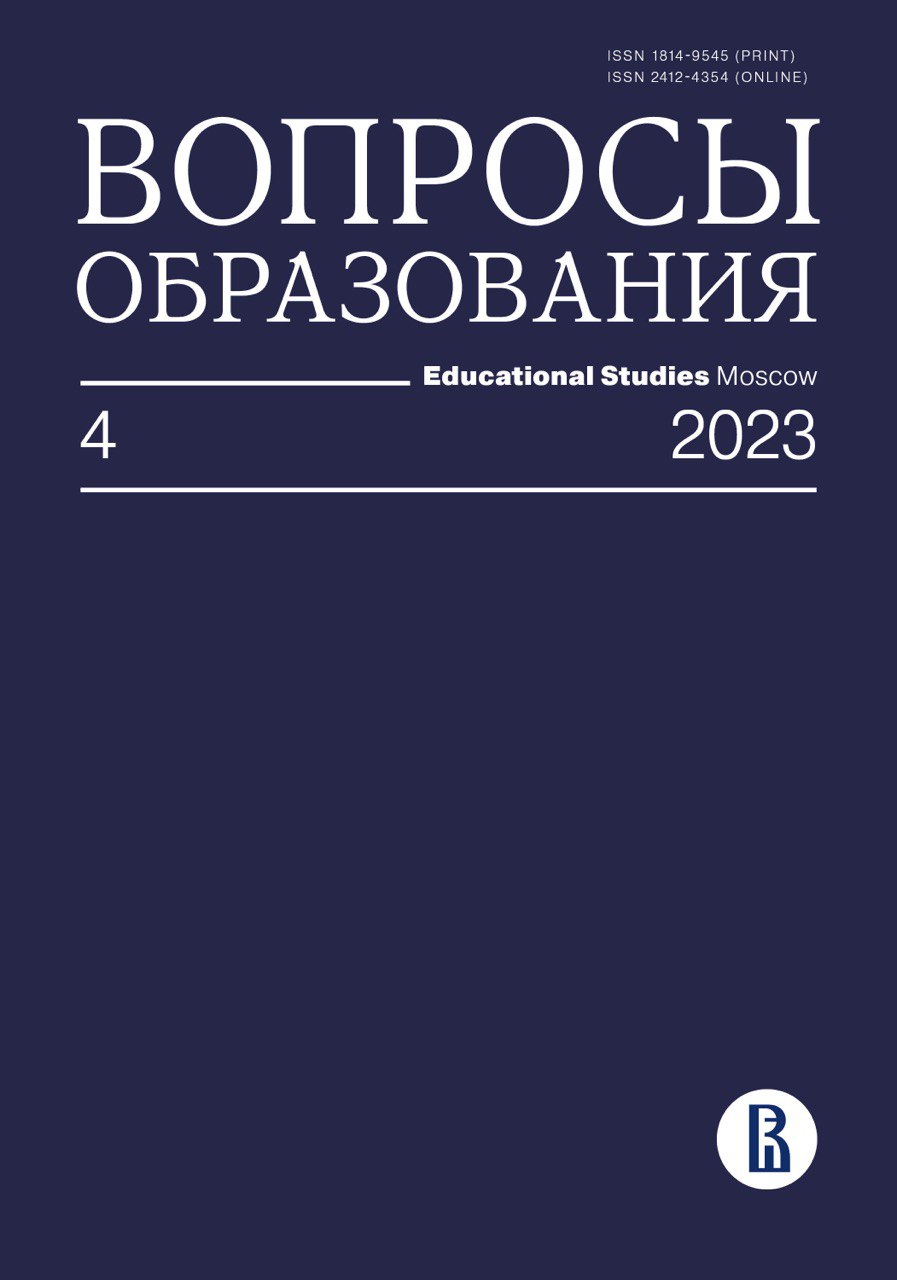Современные тренды развития нейронаучных исследований в образовании
Аннотация
Современная нейронаука делает значительные успехи в изучении функций мозга. Результаты нейронаучных исследований потенциально полезны для практики образования, однако современные нейронаучные данные о том, как мозг обучается, не находят применения в учебных аудиториях. Авторы задаются вопросом: что могут сделать ученые в области нейронауки, психологи и педагоги для выстраивания взаимодействия нейронауки с образованием?
В статье рассматриваются основные положения образовательной нейронауки как междисциплинарной области исследований на стыке нейробиологии, педагогики и когнитивной науки, которая стремится внедрить результаты исследований о нейронных механизмах обучения в образовательную практику и оценить влияние образования на мозг обучающегося. Описаны истоки и современный прогресс нейронауки в образовании, обсуждается терминологическая неопределенность в российской научной литературе, посвященной взаимосвязи нейронауки и образования, а также возможные и наиболее перспективные пути взаимодействия психологии, педагогики и нейронауки. Проведен наукометрический анализ основных направлений исследований в области взаимодействия нейронауки с образованием на основе базы данных научной литературы Scopus.
Скачивания
Литература
Alloway T.P., Alloway R.G. (2014) Understanding Working Memory. Thousand Oaks, CA: Sage.
Amso D., Scerif G. (2015) The Attentive Brain: Insights from Developmental Cognitive Neuroscience. Nature Reviews Neuroscience, vol. 16, no 10, pp. 606–619. https://doi.org/10.1038/nrn4025
Baars B.J. (1997) In the Theatre of Consciousness. Global Workspace Theory, a Rigorous Scientific Theory of Consciousness. Journal of Consciousness Studies, vol. 4, no 4, pp. 292–309.
Bazhanov V.A., Shkurko YU.S. (2018) Sovremennaya nejronauka i obrazovanie: novye argumenty v pol'zu staryh priemov [Modern Neuroscience and Education: New Arguments in Favor of Old Techniques]. Pedagogika, no 8, pp. 29–38.
Bastarrika A., Davidson D. (2017) An Event Related Field Study of Rapid Grammatical Plasticity in Adult Second-Language Learners. Frontiers in Human Neuroscience, vol. 11, January, Article no 12. https://doi.org/10.3389/fnhum.2017.00012
Beauchamp C., Beauchamp M.H. (2013) Boundary as Bridge: An Analysis of the Educational Neuroscience Literature from a Boundary Perspective. Educational Psychology Review, vol. 25, no 1, pp. 47–67. https://doi.org/10.1007/s10648-012-9207-x
Bernacki M.L., Walkington С. (2018) The Role of Situational Interest in Personalized Learning. Journal of Educational Psychology, vol. 110, no 6, pp. 864–881. https://doi.org/10.1037/edu0000250
Bowers J.S. (2016a) Psychology, Not Educational Neuroscience, Is the Way Forward for Improving Educational Outcomes for All Children: Reply to Gabrieli (2016) and Howard-Jones et al. (2016). Psychological Review, vol. 123, no 5, pp. 628–635. https://doi.org/10.1037/rev0000043
Bowers J.S. (2016b) The Practical and Principled Problems with Educational Neuroscience. Psychological Review, vol. 123, no 5, pp. 600–612. https://doi.org/10.1037/rev0000025
Brockington G., Balardin J.B., Morais G., Malheiros A., Lent R., Moura L., Sato J.R. (2018) From the Laboratory to the Classroom: The Potential of Functional Near-Infrared Spectroscopy in Educational Neuroscience. Frontiers in Psychology, vol. 9, October, Article no 1840. https://doi.org/10.3389/fpsyg.2018.01840
Brookman-Byrne A., Thomas M.S.C. (2018) Neuroscience, Psychology and Education: Emerging Links. Impact, no 2, pp. 5–8.
Bruce C.D., Davis B., Sinclair N., McGarvey L., Hallowell D., Drefs M., Francis K. et al. (2017) Understanding Gaps in Research Networks: Using “Spatial Reasoning” as a Window into the Importance of Networked Educational Research. Educational Studies in Mathematics, vol. 95, no 2, pp. 143–161. https://www.jstor.org/stable/45184558
Bruel-Jungerman E., Davis S., Laroche S. (2007) Brain Plasticity Mechanisms and Memory: A Party of Four. The Neuroscientist, vol. 13, no 5, pp. 492–505. https://doi.org/10.1177/107385840730
Bruer J. T. (1997). Education and the Brain: A Bridge Too Far. Educational Researcher, vol. 26, no 8, pp. 4–16. https://doi.org/10.3102/0013189X026008004
Budgen S., DeWind N.K., Brannon E.M. (2016) Using Cognitive Training Studies to Unravel the Mechanisms by Which the Approximate Number System Supports Symbolic Math Ability. Current Opinion in Behavioral Sciences, vol. 10, May, pp. 73–80. https://doi.org/10.1016/j.cobeha.2016.05.002
Budson A.E., Richman K.A., Kensinger E.A. (2022) Consciousness as a Memory System. Cognitive and Behavioral Neurology, vol. 35, no 4, pp. 263–297. https://doi.org/10.1097/WNN.0000000000000319
Bukina T.V., Khramova M.V., Kurkin S.A. (2021) Sovremennye issledovaniya funktsionirovaniya mozga detej mladshego shkol'nogo vozrasta v protsesse obucheniya: obzor [Modern Research on Primary School Children Brain Functioning in the Learning Process: Review]. Izvestiya VUZ. Applied Nonlinear Dynamics, vol. 29, no 3, pp. 449–456. https://doi.org/10.18500/0869-6632-2021-29-3-449-456
Bulger M. (2016) Personalized Learning: The Conversations We’re Not Having. Data & Society Research Institute Working Paper 07.22.2016. Available at: https://www.datasociety.net/pubs/ecl/PersonalizedLearning_primer_2016.pdf (accessed 20 June 2023).
Butterworth B., Varma S. (2013). Mathematical Development. Educational Neuroscience (eds D. Mareschal, B. Butterworth, A. Tolmie), Oxford, UK: Wiley Blackwell, pp. 201–236.
Caligiore D., Arbib M.A., Miall R.C., Baldassarre G. (2019) The Super-Learning Hypothesis: Integrating Learning Processes across Cortex, Cerebellum and Basal Ganglia. Neuroscience & Biobehavioral Reviews, vol. 100, February, pp. 19–34. https://doi.org/10.1016/j.neubiorev.2019.02.008
Caligiore D., Pezzulo G., Baldassarre G., Bostan A.C., Strick P.L., Doya K. et al. (2017) Consensus Paper: Towards a Systems-Level View of Cerebellar Function: The Interplay between Cerebellum, Basal Ganglia, and Cortex. The Cerebellum, vol. 16, no 1, pp. 203–229. https://doi.org/10.1007/s12311-016-0763-3
Chandler J. A., Harrel N., Potkonjak T. (2019) Neurolaw Today–A Systematic Review of the Recent Law and Neuroscience Literature. International Journal of Law and Psychiatry, vol. 65, no 1, Article no 101341. https://doi.org/10.1016/j.ijlp.2018.04.002
Clement N.D., Lovat T. (2012) Neuroscience and Education: Issues and Challenges for Curriculum. Curriculum Inquiry, vol. 42, no 4, pp. 534–557. https://doi.org/10.1111/j.1467-873X.2012.00602.x
Daley N., Rawson A.K. (2019) Elaborations in Expository Text Impose a Substantial Time Cost but Do Not Enhance Learning. Educational Psychology Review, vol. 31, no 2, pp. 197–222. https://doi.org/10.1007/s10648-018-9451-9
De Brigard F., Sinnott-Armstrong W. (eds) (2022) Neuroscience and Philosophy. Cambridge, MA,
London, England: MIT Press. https://doi.org/10.7551/mitpress/12611.001.0001
Davidesco I., Matuk C., Bevilacqua D., Poeppel D., Dikker S. (2021) Neuroscience Research in the Classroom: Portable Brain Technologies in Education Research. Educational Researcher, vol. 50, no 9, pp. 649–656. https://doi.org/10.3102/0013189X211031563
Dimitropoulos K., Mystakidis S., Fragkaki M. (2022) Bringing Educational Neuroscience to Distance Learning with Design Thinking: The Design and Development of a Hybrid E-learning Platform for Skillful Training. Proceedings of the 2022 7th South-East Europe Design Automation, Computer Engineering, Computer Networks and Social Media Conference (Ioannina, Greece, September, 23–25, 2022), pp. 1–6. https://doi.org/10.1109/SEEDA-CECNSM57760.2022.9932939
Donaldson K., Tran L., Jimenez L.A., Duffin R., Newby D.E. et al. (2005) Combustion-Derived Nanoparticles: A Review of Their Toxicology Following Inhalation Exposure. Particle and Fibre Toxicology, vol. 2, no 1, Article no 10. https://doi.org/10.1186/1743-8977-2-10
Doukakis S., Alexopoulos E.C. (2021) The Role of Educational Neuroscience in Distance Learning. Knowledge Transformation Opportunities. Proceedings of the International Conference on Interactive Collaborative and Blended Learning (Hamilton, Canada, October, 14–16, 2020), Cham: Springer, pp. 159–168. https://doi.org/10.1007/978-3-030-67209-6_18
Drugova E.A., Zhuravleva I.I., Zakharova U.S., Sotnikova V.E., Yakovleva K.I. (2022) Iskusstvenny intellect dlya uchebnoy analitiki i etapy pedagogicheskogo proektirovaniya: obzor resheniy [Artificial Intelligence for Learning Analytics and Instructional Design Steps: An Overview of Solutions]. Voprosy obrazovaniya / Educational Studies Moscow, no 4, pp. 107–153. https://doi.org/10.17323/1814-9545-2022-4-107-153
Dunlosky J., Rawson K.A., Marsh E.J., Nathan M.J., Willingham D.T. (2013) Improving Students' Learning with Effective Learning Techniques: Promising Directions from Cognitive and Educational Psychology. Psychological Science in the Public Interest, vol. 14, no 1, pp. 4–58. https://doi.org/ 10.1177/1529100612453266
Feiler J.B., Stabio M.E. (2018) Three Pillars of Educational Neuroscience from Three Decades of Literature. Trends in Neuroscience and Education, vol. 13, November, pp. 17–25. https://doi.org/10.1016/j.tine.2018.11.001
Ferrari M., Quaresima V. (2012) A Brief Review on the History of Human Functional Near-Infrared Spectroscopy (fNIRS) Development and Fields of Application. Neuroimage, vol. 63, no 2, pp. 921–935. https://doi.org/10.1016/j.neuroimage.2012.03.049
Filler A. (2010) The History, Development and Impact of Computed Imaging in Neurological Diagnosis and Neurosurgery: CT, MRI, and DTI. The Internet Journal of Neurosurgery, vol. 7, no 1. https://ispub.com/IJNS/7/1/12184
Flaugnacco E., Lopez L., Terribili C., Montico M., Zois S., Schön D. (2015) Music Training Increases Phonological Awareness and Reading Skills in Developmental Dyslexia: A Randomized Control Trial. PLoS ONE, vol. 10, no 9, Article no e0138715. https://doi.org/10.1371/journal.pone.0138715
Frith C. (2013) Making up the Mind: How the Brain Creates Our Mental World. Hoboken, NJ John Wiley & Sons.
Goswami U. (2017) A Neural Basis for Phonological Awareness? An Oscillatory ‘Temporal Sampling’ Perspective. Current Directions in Psychological Science, vol. 27, June, pp. 56–63. https://doi.org/10.1177/0963721417727520
Goswami U. (2016) Educational Neuroscience: Neural Structure-Mapping and the Promise of Oscillations. Current Opinion in Behavioral Sciences, vol. 10, May, pp. 89–96. https://doi.org/10.1016/j.cobeha.2016.05.011
Goswami U. (2006) Neuroscience and Education: From Research to Practice? Nature Reviews Neuroscience, vol. 7, no 5, pp. 406–413. https://doi.org/10.1038/nrn1907
Han H., Soylu F., Anchan D. M. (2019) Connecting Levels of Analysis in Educational Neuroscience: A Review of Multi-Level Structure of Educational Neuroscience with Concrete Examples. Trends in Neuroscience and Education, vol. 17, July, Article no 100113. http://dx.doi.org/10.1016/j.tine.2019.100113
Hattie J. (2021) Vidimoe obuchenie dlya uchiteley. Kak povysit´ effektivnost´ pedagogicheskoy raboty [Visible Learning for Teachers. Maximizing Impact on Learning]. Moscow: Natsional´noe obrazovanie.
Hille K. (2011) Bringing Research into Educational Practice: Lessons Learned. Mind, Brain, and Education, vol. 5, no 2, pp. 63–70. https://doi.org/10.1111/j.1751-228X.2011.01111.x
Hirsh-Pasek K., Bruer J. T. (2007) The Brain/Education Barrier. Science, vol. 317, no 5843, pp. 1293–1293. https://doi.org/10.1126/science.1148983
Hoeft F., McCandliss B.D., Black J.M., Gantman A., Zakerani N., Hulme C. et al. (2011) Neural Systems Predicting Long-Term Outcome in Dyslexia. PNAS, vol. 108, no 1, pp. 361–366. https://doi.org/10.1073/pnas.1008950108
Howard-Jones P. (2014) Neuroscience and Education: Myths and Messages. Nature Reviews Neuroscience, vol. 15, no 2, pp. 817–824. https://doi.org/10.1038/nrn3817
Howard-Jones P., Varma S., Ansari D., Butterworth B., De Smedt B., Goswami U., Thomas M.S.C. (2016) The Principles and Practices of Educational Neuroscience: Commentary on Bowers (2016). Psychological Review, vol. 123, no 5, pp. 620–627. https://doi.org/10.1037/rev0000036
Hramov A.E., Frolov N.S., Maksimenko V.A., Kurkin S.A., Kazantsev V.B., Pisarchik A.N. (2021a) Funktsional´nye seti golovnogo mozga: ot vosstanovleniya svyazey do dinamicheskoy integratsii [Functional Networks of the Brain: From Connectivity Restoration to Dynamic Integration]. Physics - Uspekhi. vol. 64, no 6, pp. 584–616. https://doi.org/10.3367/UFNe.2020.06.038807
Hramov A.E., Maksimenko V.A., Frolov N.S., Kurkin S.A., Grubov V.V., Badarin A.A. et al. (2021b) Monitoring sostoyaniya golovnogo mozga cheloveka v zadachakh prinyatiya resheniy pri vospriyatii stimulov [Human Brain State Monitoring in Perceptual Decision-Making Tasks]. Izvestiya Vysshikh Uchebnykh Zavedeniy. Applied Nonlinear Dynamics, vol. 29, no 4, pp. 603–634. https://doi.org/10.18500/0869-6632-2021-29-4-603-634
Hramov A.E., Maksimenko V.A., Pisarchik A.N. (2021) Physical Principles of Brain-Computer Interfaces and Their Applications for Rehabilitation, Robotics and Control of Human Brain States. Physics Reports, vol. 918, no 6, pp. 1–133. https://doi.org/10.1016/j.physrep.2021.03.002
Hruby G.G., Goswami U. (2018) Educational Neuroscience for Reading Researchers. Theoretical Models and Processes of Literacy (eds D.E. Alvermann, N.J. Unrau, M. Sailors, R.B. Ruddell), New York, NY: Routledge, pp. 252–277. https://doi.org/10.4324/9781315110592
Jiang F., VanDyke R.D., Zhang J., Li F., Gozal D., Shen X. (2011) Effect of Chronic Sleep Restriction on Sleepiness and Working Memory in Adolescents and Young Adults. Journal of Clinical and Experimental Neuropsychology, vol. 33, no 8, pp. 892–900. https://doi.org/10.1080/13803395.2011.570252
Karpov O.E., Hramov A.E. (2022) Informatsionnye tekhnologii, vychislitel'nye sistemy i iskusstvennyj intellekt v medicine [Information Technologies, Computing Systems and Artificial Intelligence in Medicine]. Moscow: DPK Press.
Kedia G., Harris L., Lelieveld G.-J., van Dillen L. (2017) From the Brain to the Field: The Applications of Social Neuroscience to Economics, Health and Law. Brain Sciences, vol. 7, no 8, Article no 94. https://doi.org/10.3390/brainsci7080094
Khramova M.V., Kuc A.K., Maksimenko V.A., Frolov N.S., Grubov V.V., Kurkin S.A. et al. (2021) Monitoring the Cortical Activity of Children and Adults during Cognitive Task Completion. Sensors, vol. 21, no 18, Article no 6021. https://doi.org/10.3390/s21186021
Klemantovich I.P., Levanova E.A., Stepanov V.G. (2016) Nejropedagogika: novaya otrasl' nauchnykh znanij [Neuropedagogy: A New Branch of Scientific Knowledge]. Pedagogika i psikhologiya obrazovaniya / Pedagogy and Psychology of Education, no 2, pp. 8–17.
Klöckner C.A., Verplanken B. (2018) Yesterday's Habits Preventing Change for Tomorrow? About the Influence of Automaticity on Environmental Behaviour. Environmental Psychology: An Introduction (eds L. Steg, J.I.M. de Groot), Oxford: Wiley-Blackwell, pp. 238–250. https://doi.org/10.1002/9781119241072.ch24
Knowland V.C.P, Thomas M. (2014) Educating the Adult Brain: How the Neuroscience of Learning Can Inform Educational Policy. International Review of Education, vol. 60, no 1, pp. 99–122. https://doi.org/10.1007/s11159-014-9412-6
Koelsch S. (2012) The Brain and Music. Oxford, UK: Wiley-Blackwell.
Kostromina S.N., Bordovskaya N.V., Iskra N.N., Chuvgunova O.A., Gnedykh D.S., Kurmakaeva D.M. (2015) Nejronauka, psikhologiya i obrazovanie: problemy i perspektivy mezhdistsiplinarnykh issledovanij [Neuroscience, Psychology and Education: Problems and Prospects for Interdisciplinary Studies]. Psychological Journal, vol. 36, no 4, pp. 61–70.
Koziol L.F., Budding D.E., Chidekel D. (2011) Sensory Integration, Sensory Processing, and Sensory Modulation Disorders: Putative Functional Neuroanatomic Underpinnings. The Cerebellum, vol. 10, no 4, pp. 770–792. https://doi.org/10.1007/s12311-011-0288-8
Krueger F., Meyer-Lindenberg A. (2019) Toward a Model of Interpersonal Trust Drawn from Neuroscience, Psychology, and Economics. Trends in Neurosciences, vol. 42, no 2, pp. 92–101. https://doi.org/10.1016/j.tins.2018.10.004
Kulikova O.V. (2014) Nejrodidakticheskiy podkhod kak faktor povysheniya kachestva obucheniya inoyazychnomu professional'nomu obshcheniyu [The Neurodidactic Approach as a Factor of Quality Improvement: Teaching Professional Communication in Foreign Languages]. Vestnik of Moscow State Linguistic University: Educationa and Teaching, no 14 (700), cc. 107–114.
Kurkin S.A., Grubov V.V., Maksimenko V.A., Pitsik E.N., Khramova M.V., Hramov A.E. (2020) Sistema dlya kontrolya i korrektirovki protsessa obucheniya mladshikh shkol'nikov na baze analiza dannykh EEG [System for Monitoring and Adjusting the Learning Process of Primary Schoolchildren Based on EEG Data Analysis]. Information and Control Systems, no 5 (108), pp. 50–61, https://doi.org/10.31799/1684-8853-2020-5-50-61
Lau-Zhu A., Lau M.P.H., McLoughlin G. (2019) Mobile EEG in Research on Neurodevelopmental Disorders: Opportunities and Challenges. Developmental Cognitive Neuroscience, vol. 36, March, Article no 100635. https://doi.org/10.1016/j.dcn.2019.100635
Lăzăroiu G., Pera A., Ștefănescu-Mihăilă R.O., Mircică N., Negurită O. (2017) Can Neuroscience Assist Us in Constructing Better Patterns of Economic Decision-Making? Frontiers in Behavioral Neuroscience, vol. 11, October, Article no 188. https://doi.org/10.3389/fnbeh.2017.00188
Leisman G. (2023) Neuroscience in Education: A Bridge Too Far or One That Has Yet to Be Built: Introduction to the “Brain Goes to School”. Brain Sciences, no 13, Article no 40. https://doi.org/10.3390/brainsci13010040
LeDoux J.E. (1993) Emotional Memory Systems in the Brain. Behavioural Brain Research, vol. 58, no 1-2, pp. 69–79. https://doi.org/10.1016/0166-4328(93)90091-4
Liu T., Liu X., Yi L., Zhu C., Markey P.S., Pelowski M. (2019) Assessing Autism at Its Social and Developmental Roots: A Review of Autism Spectrum Disorder Studies Using Functional Near-Infrared Spectroscopy. Neuroimage, vol. 185, January, pp. 955–967. https://doi.org/10.1016/j.neuroimage.2017.09.044
Lo J.C., Ong J.L., Leong R.L., Gooley J.J., Chee M.W. (2016) Cognitive Performance, Sleepiness, and Mood in Partially Sleep Deprived Adolescents: The Need for Sleep Study. Sleep, vol. 39, no 3, pp. 687–698. https://doi.org/10.5665/sleep.5552
Maksimenko V.A., Runnova A.E., Zhuravlev M.O., Protasov P., Kulanin R., Khramova M.V., Pisarchik A.N., Hramov A.E. (2018) Human Personality Reflects Spatio-Temporal and Time-Frequency EEG Structure. PLoS One, vol. 13, no 9, Article no e0197642. https://doi.org/10.1371/journal. pone.0197642
Malsagov A.A., Lezina V.V. (2021) Nejrodidaktika v Rossii: razvitie i perspektivy [Neurodidactics in Russia: Development and Prospects]. Mir nauki, kul'tury, obrazovaniya, no 4 (89), pp. 149–151. https://doi.org/10.24412/1991-5497-2021-489-149-150
Mareschal D., Johnson M., Sirios S., Spratling M., Thomas M.S.C., Westermann G. (2007) Neuroconstructivism: How the Brain Constructs Cognition. Oxford: Oxford University.
Markowitsch H.J., Welzer H. (2009) The Development of Autobiographical Memory. New York, NY: Psychology Press.
Menon V. (2016) Working Memory in Children's Math Learning and Its Disruption in Dyscalculia. Current Opinion in Behavioral Sciences, vol. 10, June, pp. 125–132. https://doi.org/10.1016/j.cobeha.2016.05.014
Mercer N. (2000) Words and Minds: How We Use Language to Think Together. London: Routledge.
Miozzo M., Pulvermuller F., Hauk O. (2015) Early Parallel Activation of Semantics and Phonology in Picture Naming: Evidence from a Multiple Linear Regression MEG Study. Cereb Cortex, vol. 25, no 10. https://doi.org/10.1093/cercor/bhu137
Newcombe N.S. (2016) Thinking Spatially in the Science Classroom. Current Opinion in Behavioral Sciences, vol. 10, August, pp. 1–6. https://doi.org/10.1016/j.cobeha.2016.04.010
Oberman L.M., Ramachandran V.S. (2007) The Simulating Social Mind: The Role of the Mirror Neuron System and Simulation in the Social and Communicative Deficits of Autism Spectrum Disorders. Psychological Bulletin, vol. 133, no 2, pp. 310–327. https://doi.org/10.1037/0033-2909.133.2.310
Park H.-J., Friston K. (2013) Structural and Functional Brain Networks: From Connections to Cognition. Science, vol. 342, no 6158, Article no 1238411. https://doi.org/10.1126/science.1238411
Petersen S.E., Posner M.I. (2012) The Attention System of the Human Brain: 20 Years after. Annual Review of Neuroscience, vol. 35, no 1, pp. 73–89. https://doi.org/10.1146%2Fannurev-neuro-062111-150525
Pisarchik A.N, Khorev V.S., Badarin A.A., Antipov V.M., Budarina A.O., Hramov A.E. (2023) Metodologiya dizajna nejrofiziologicheskikh eksperimentov s pred"yavleniem vizual'nykh stimulov dlya otsenki urovnya vladeniya inostrannym yazykom [Methodology of the Neurophysiological Experiments with Visual Stimuli to Assess Foreign Language Proficiency]. Izvestiya VUZ. Applied Nonlinear Dynamics. vol. 31, no 2, pp. 202–224. https://doi.org/10.18500/0869-6632-003031
Pua E.P.K., Barton S., Williams K., Craig J.M., Seal M.L. (2020) Individualised MRI Training for Paediatric Neuroimaging: A Child-Focused Approach. Developmental Cognitive Neuroscience, vol. 41, no 1, Article no 100750. https://doi.org/10.1016/j.dcn.2019.100750
Quaresima V., Ferrari M. (2019) A Mini-Review on Functional Near-Infrared Spectroscopy (fNIRS): Where Do We Stand, and Where Should We Go? Photonics, vol. 6, no 3, Article no 87. https://doi.org/10.3390/photonics6030087
Rea S.D., Wang L., Muenks K., Yan V. (2022) Students Can (Mostly) Recognize Effective Learning, So Why Do They Not Do It? Journal of Intelligence, vol. 10, no 4, Article no 127. https://doi.org/10.3390/jintelligence10040127
Roediger H.L. (2013) Applying Cognitive Psychology to Education: Translational Educational Science. Psychological Science in the Public Interest, vol. 14, no 1, pp. 1–3. https://doi.org/10.1177/1529100612454415
Rohrer D., Pashler H. (2012) Learning Styles: Where's the Evidence? Medical Education, vol. 46, no 7, pp. 634–635. https://doi.org/10.1111/j.1365-2923.2012.04273.x
Rueda M.R. (2018) Attention in the Heart of Intelligence. Trends in Neuroscience and Education, vol. 13, November, pp. 26–33. https://doi.org/10.1016/j.tine.2018.11.003
Ruiz-Ariza A., Grao-Cruces A., Marques de Loureiro N.E., Martínez-López E.J. (2017) Influence of Physical Fitness on Cognitive and Academic Performance in Adolescents: A Systematic Review from 2005–2015. International Review of Sport and Exercise Psychology, vol. 10, no 1, pp. 108–133. https://doi.org/10.1080/1750984X.2016.1184699
Sala G., Fernand G. (2017) Does Far Transfer Exist? Negative Evidence from Chess, Music, and Working Memory Training. Current Directions in Psychological Science, vol. 26, no 6, pp. 515–520. https://doi.org/10.1177/09637214177127
Salzman C. D., Fusi S. (2010) Emotion, Cognition, and Mental State Representation in Amygdala and Prefrontal Cortex. Annual Review of Neuroscience, vol. 33, no 1, pp. 173–202. https://doi.org/10.1146/annurev.neuro.051508.135256
Sianipar A., Middelburg R., Dijkstra T. (2015) When Feelings Arise with Meanings: How Emotion and Meaning of a Native Language Affect Second Language Processing in Adult Learners. PLoS One, vol. 10, no 12, Article no e0144576. https://doi.org/10.1371/journal.pone.0144576
Sigman M., Peña M., Goldin A., Riberio S. (2014) Neuroscience and Education: Prime Time to Build the Bridge. Nature Neuroscience, vol. 17, no 4, pp. 497–502. https://doi.org/10.1038/nn.3672
Simons D.J., Boot W.R., Charness N., Gathercole S.E., Chabris C.F., Hambrick D.Z., Stine-Morrow E.A.L. (2016) Do “Brain-Training” Programs Work? Psychological Science in the Public Interest, vol. 17, no 3, pp. 103–186. https://doi.org/10.1177/1529100616661983
Sisk V.F., Burgoyne A.P., Sun J., Butler J.L., Macnamara B.N. (2018) To What Extent and under which Circumstances Are Growth Mind-Sets Important to Academic Achievement? Two Meta-Analyses. Psychological Science, vol. 29, no 4, pp. 549–571. https://doi.org/10.1177/0956797617739704
Shaw P., Watson M.M., Greenstein V, de Rossi P., Sharp W. (2013) Trajectories of Cerebral Cortical Development in Childhood and Adolescence and Adult Attention-Deficit / Hyperactivity Disorder. Biological Psychiatry, vol. 74, no 8, pp. 599–606. https://doi.org/10.1016/j.biopsych.2013.04.007
Skau S., Helenius O., Sundberg K., Bunketorp-Käll L., Kuhn H. G. (2022) Proactive Cognitive Control, Mathematical Cognition and Functional Activity in the Frontal and Parietal Cortex in Primary School Children: An fNIRS Study. Trends in Neuroscience and Education. vol. 28, no 10, Article no 100180. https://doi.org/10.1016/j.tine.2022.100180
Soltanlou M., Sitnikova M.A., Nuerk H., Dresler T. (2018) Applications of Functional Near-Infrared Spectroscopy (fNIRS) in Studying Cognitive Development: The Case of Mathematics and Language. Frontiers in Psychology, vol. 9, April, Article no 277. https://doi.org/10.3389/fpsyg.2018.00277
Sonmez A.I., Camsari D.D., Nandakumar A.L., Vande Voort J.L., Kung S., Lewis C.P., Croarkin P.E. (2019) Accelerated TMS for Depression: A Systematic Review and Meta-Analysis. Psychiatry Research, vol. 273, March, pp. 770–781. https://doi.org/10.1016/j.psychres.2018.12.041
Soufineyestani M., Dowling D., Khan A. (2020) Electroencephalography (EEG) Technology Applications and Available Devices. Applied Sciences, vol. 10, no 21, Article no 7453. https://doi.org/10.3390/app10217453
Stepanov V.G. (2020) Nejropedagogika. Mozg i effektivnoe razvitie detey i vzroslykh: vozrast, obuchenie, tvorchestvo, proforientatsiya [Brain and Effective Development of Children and Adults: Age, Learning, Creativity, Career Guidance]. Moscow: Akademicheskiy proekt.
Stojanoski B., Wild C.J., Battista M.E., Nichols E.S., Owen A.M. (2021) Brain Training Habits Are Not Associated with Generalized Benefits to Cognition: An Online Study of Over 1000 “Brain Trainers”. Journal of Experimental Psychology: General, vol. 150, no 4, pp. 729–738. https://doi.org/10.1037/xge0000773
Sunyer J., Esnaola M., Alvarez-Pedrerol M., Forns J., Rivas I. et al. (2015) Association between Traffic-Related Air Pollution in Schools and Cognitive Development in Primary School Children: A Prospective Cohort Study. PLoS Medicine, vol. 12, no 3, Article no e1001792. https://doi.org/10.1371/journal.pmed.1001792
Tardif E., Doudin P.-A., Meylan N. (2015) Neuromyths among Teachers and Student Teachers. Mind, Brain, and Education, vol. 9, no 1, pp. 50–59. https://doi.org/10.1111/mbe.12070
Tikidji-Hamburyan R.A., Kropat E., Weber G.W. (2020) Preface: Operations Research in Neuroscience II. Annals of Operations Research, vol. 289, no 1, pp. 1–4. https://doi.org/10.1007/s10479-020-03574-z
Thomas M.S.C. (2013) Educational Neuroscience in the Near and Far Future: Predictions from the Analogy with the History of Medicine. Trends in Neuroscience and Education vol. 2, no 1, pp. 23–26. https://doi.org/10.1016/j.tine.2012.12.001
Thomas M.S.C., Ansari D., Knowland V.C.P. (2019) Annual Research Review: Educational Neuroscience: Progress and Prospects. Journal of Child Psychology and Psychiatry, vol. 60, no 4, pp. 477–492. https://doi.org/10.1111/jcpp.12973
Thompson J.M., Leong V., Goswami U. (2013) Auditory Processing Interventions and Developmental Dyslexia: A Comparison of Phonemic and Rhythmic Approaches. Reading and Writing, vol. 26, no 2, pp. 139–161. https://doi.org/10.1007/s11145-012-9359-6
Thorndike E.L. (1913) Educational Psychology. Vol. 1. The Original Nature of Man. New York, NY: Columbia University. https://doi.org/10.1037/13763-000
Vygotskij L.S. (1934) Myshlenie i rech' [Mind and Speech]. Leningrad: Gosudarstvennoe social'no-ekonomicheskoe izdatel'stvo.
Wanalee K., Katz R., Vallée A.L. (2015) Basic Principles of Transcranial Magnetic Stimulation (TMS) and Repetitive TMS (rTMS). Annals of Physical and Rehabilitation Medicine, vol. 58, no 4, pp. 208–213. https://doi.org/10.1016/j.rehab.2015.05.005
Wazny J.H., Nathan-Roberts D. (2018) Real-Time Cognitive-State Neuroimaging in Applied Education. Proceedings of the Human Factors and Ergonomics Society Annual Meeting, vol. 62, no 1, pp. 1157–1161. Los Angeles, CA: Sage. https://doi.org/10.1177/15419312186212
Williamson B. (2019) Brain Data: Scanning, Scraping and Sculpting the Plastic Learning Brain through Neurotechnology. Postdigital Science and Education, vol. 1, no 1, pp. 65–86. https://doi.org/10.1007/s42438-018-0008-5
Willingham D.T. (2018) Unlocking the Science of How Kids Think: A New Proposal for Reforming Teacher Education. Education Next, vol. 18, no 3, pp. 42–49.
Willingham D.T. (2009) Three Problems in the Marriage of Neuroscience and Education. Cortex, vol. 45, no 4, pp. 544–545. https://doi.org/10.1016/j.cortex.2008.05.009
Wininger S.R., Redifer J.L., Norman A.D., Ryle M.K. (2019) Prevalence of Learning Styles in Educational Psychology and Introduction to Education Textbooks: A Content Analysis. Psychology Learning & Teaching, vol. 18, no 3, pp. 221–243, https://doi.org/10.1177/1475725719830301
Xu J., Zhong B. (2018) Review on Portable EEG Technology in Educational Research. Computers in Human Behavior, vol. 81, December, pp. 340–349. https://doi.org/10.1016/j.chb.2017.12.037
Zeer E.F. (2021) Nejrodidaktika — innovatsionny trend personalizirovannogo obrazovaniya [Neurodidactics — an Innovative Trend of Personalised Education]. Vocational Education and Labour Market, no 4, pp. 30–38. https://doi.org/10.52944/ P0RT.2021.47.4.002
Zull J.E. (2020) The Art of Changing the Brain: Enriching the Practice of Teaching by Exploring the Biology of Learning. Sterling, VA: Stylus.








